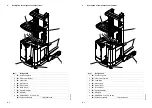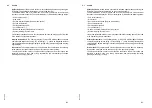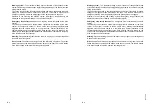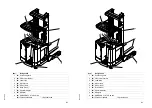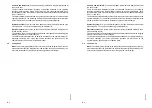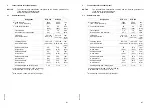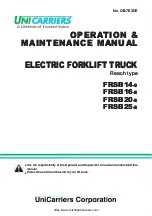
B 1
0
107
.USA
B Recognition and avoidance of risks
In its 1998 investigation into the use of powered industrial trucks, OSHA determined
the ways in which accidents commonly occur and the causes of these accidents.
OSHA concluded that considerable risks to operators themselves and to other people
in their immediate vicinity can be put down to the inadequate or non-existent training
of operating personnel. According to OSHA, incorrect and unsafe operation are the
principal causes of accidents in connection with powered industrial trucks and the
resulting injuries and fatalities. It is therefore no coincidence that in reviewing its own
research, OSHA found that in almost all cases, accidents were attributable to
situations or actions, which the operator, or the employer and the operator together,
could have influenced or could have done better. This finding was confirmed by a
simple check of the accident causes cited by OSHA. Of the 208 accidents
investigated involving powered industrial trucks, 184 of which were fatal accidents or
resulted in serious injuries, a full 50 percent of them were due to loading problems,
including overloading, unstable loads, dropped loads or incorrect lifting of loads.
25 percent of the cases involved the tipping or overturning of the truck. A further
20 percent of the accidents were caused by the truck falling from a platform or a trailer
or by persons falling from an elevated position in a truck. Although only 4% of the
accidents were due to an absence of training and instruction, OSHA nevertheless
noted that many accidents could also have been caused by inadequate training. For
example, the overturning of a vehicle could just as easily be caused by poor or
inadequate instruction of the operator with regard to the loading of the vehicle. Other
less frequent accident causes, which could nevertheless still have been avoided by
employers and operators, were excessive speeds and the use of inappropriate
equipment.
The following measures are, therefore, of vital importance:
– Operators must be trained and aptitude-tested before working with a powered
industrial truck.
– Operators must be physically, mentally and emotionally capable of operating a
powered industrial truck.
– Operators must possess and apply all practical knowledge in relation to the safe
loading and correct operation of the vehicle. The capacity limits of the machine
must be known and must never be exceeded.
– All circumstances, which could cause the vehicle to tip or to overturn, must be
avoided. Attention must be paid in this regard to shifting centers of gravity, correct
loading and the safe transport of loads, and to anticipatory driving, taking account
of edges, bends, slopes, and other driving conditions.
– Without appropriate driver training and the correct type of truck, passengers should
never be carried nor people lifted under any circumstances. Furthermore, the
correct procedure for this must be observed.
– Traffic rules must always be observed. Drivers must always be aware of the
position of colleagues and of other trucks and must pay attention to local
conditions.
B 1
0
107
.USA
B Recognition and avoidance of risks
In its 1998 investigation into the use of powered industrial trucks, OSHA determined
the ways in which accidents commonly occur and the causes of these accidents.
OSHA concluded that considerable risks to operators themselves and to other people
in their immediate vicinity can be put down to the inadequate or non-existent training
of operating personnel. According to OSHA, incorrect and unsafe operation are the
principal causes of accidents in connection with powered industrial trucks and the
resulting injuries and fatalities. It is therefore no coincidence that in reviewing its own
research, OSHA found that in almost all cases, accidents were attributable to
situations or actions, which the operator, or the employer and the operator together,
could have influenced or could have done better. This finding was confirmed by a
simple check of the accident causes cited by OSHA. Of the 208 accidents
investigated involving powered industrial trucks, 184 of which were fatal accidents or
resulted in serious injuries, a full 50 percent of them were due to loading problems,
including overloading, unstable loads, dropped loads or incorrect lifting of loads.
25 percent of the cases involved the tipping or overturning of the truck. A further
20 percent of the accidents were caused by the truck falling from a platform or a trailer
or by persons falling from an elevated position in a truck. Although only 4% of the
accidents were due to an absence of training and instruction, OSHA nevertheless
noted that many accidents could also have been caused by inadequate training. For
example, the overturning of a vehicle could just as easily be caused by poor or
inadequate instruction of the operator with regard to the loading of the vehicle. Other
less frequent accident causes, which could nevertheless still have been avoided by
employers and operators, were excessive speeds and the use of inappropriate
equipment.
The following measures are, therefore, of vital importance:
– Operators must be trained and aptitude-tested before working with a powered
industrial truck.
– Operators must be physically, mentally and emotionally capable of operating a
powered industrial truck.
– Operators must possess and apply all practical knowledge in relation to the safe
loading and correct operation of the vehicle. The capacity limits of the machine
must be known and must never be exceeded.
– All circumstances, which could cause the vehicle to tip or to overturn, must be
avoided. Attention must be paid in this regard to shifting centers of gravity, correct
loading and the safe transport of loads, and to anticipatory driving, taking account
of edges, bends, slopes, and other driving conditions.
– Without appropriate driver training and the correct type of truck, passengers should
never be carried nor people lifted under any circumstances. Furthermore, the
correct procedure for this must be observed.
– Traffic rules must always be observed. Drivers must always be aware of the
position of colleagues and of other trucks and must pay attention to local
conditions.
Summary of Contents for ETR 314
Page 1: ...Operating instructions 50 452 907 ETR 314 320 u 06 06 11 09 07 08 E Manual de instrucciones...
Page 7: ...0608 USA I 4 0608 USA I 4...
Page 9: ...0606 USA A 2 0606 USA A 2...
Page 24: ...D 9 0107 USA D 9 0107 USA...
Page 26: ...D 11 0107 USA D 11 0107 USA...
Page 103: ...0107 USA F 10 0107 USA F 10...
Page 123: ...0708 USA G 20 0708 USA G 20...
Page 135: ...0608 E I 4 0608 E I 4...
Page 137: ...0606 E A 2 0606 E A 2...
Page 152: ...D 9 0107 E D 9 0107 E...
Page 154: ...D 11 0107 E D 11 0107 E...
Page 225: ...0608 E E 66 0608 E E 66...
Page 235: ...0107 E F 10 0107 E F 10...
Page 255: ...0708 E G 20 0708 E G 20...

















